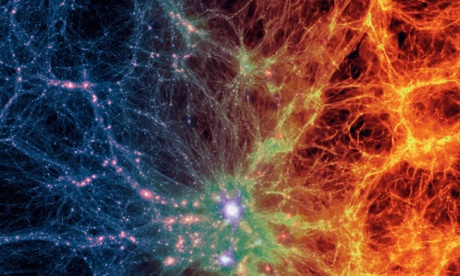
Dark matter is an enduring and exciting puzzle in physics. Multiple astrophysical observations give really strong evidence that most of the matter out there in the universe is invisible – or, more precisely, only affects other matter via its gravitational attraction. Cosmological models, which we use to understand (and simulate) how the universe developed over time, also require dark matter in order to describe what we see around us.
There is always the possibility that we don’t understand gravity and cosmology as well as we think we do, but it is very hard to modify gravity in a way that describes all the data. So many tweaks that need to be made, and special cases accounted for, that most physicists give up and reluctantly accept the idea that 85% of the matter in the universe is dark. Worse, while neutrinos are invisible enough to fit the bill, they are not massive enough, and therefore they don’t clump together enough, so can only account for a tiny fraction of the total dark matter. All the other particles in the Standard Model of particle physics interact with light. So they aren’t dark. So dark matter has to be something very new, which makes it interesting for particle physics as well as cosmology.
There are at least three very different ways of looking for dark matter. You can try and make it in particle accelerators. You can look for signs of dark matter particles annihilating each other in the centre of massive bodies that they must clump around – the centres of galaxies, maybe even the sun. And perhaps most directly, you can look for rare, glancing collisions between normal matter in a detector here on Earth, and the dark matter cloud the Earth is assumed to be continually rushing through.
On the accelerator front, we have had no luck so far, but watch out when the Large Hadron Collider at CERN steps up in energy next year. Lately though, experiments using the other two methods have seen a variety of often-contradictory hints. This is a sign of how much progress is being made in improved sensitivity, but also of how challenging the search is. Not all of these hints can be right.
One such hint came from the CoGeNT collaboration. The CoGeNT detector is made of germanium crystals. Collisions between dark matter particles and the germanium lead to tiny energy deposits which can be detected because the germanium has very low electronic "noise". Near the surface of the crystal, backgrounds other than dark matter collisions can give signals. However, in the bulk of the crystal, the dark matter signal should dominate. That's what they are looking for.
The CoGeNT team recently released an update of their analysis, including more data (an increase from 807 to 1,136 days of searching), and crucially they released the actual data in a form such that they could be reanalysed. This week, a reanalysis of these data by an independent team of scientists from Durham and Annecy (Davis, McCabe and Boehm) appeared.
The reanalysis throws some cold water on the hint, sadly. The analysis of CoGeNT data relies on the ability to distinguish energy deposits which occur near the surface of the detector from those occurring inside its bulk. Because the position of the energy deposit is not itself measured, the separation between surface and bulk deposits is done by analysing the shape of the energy pulse (specifically, how quickly the energy rises from zero). The contribution from the surface "background" energies deposits has to then be understood, modelled, and subracted from the data, hopefully leaving only the dark matter signal behind. Davis, McCabe and Boehm argue convincingly that the uncertainty in this modelling is larger than was assumed by the CoGeNT team, and once this is taken into account, that particular hint essentially vanishes.
One might argue about the CoGeNT team's data analysis, but not about their integrity as scientists. Davis, McCabe and Boehm thank them for releasing the data, and so should we all. Dark matter is very exciting and its discovery would have far-reaching implications; evaluating the confidence level in any new result is therefore very important.
Dark matter isn't the only important unknown out there. In fact there are many more out there, often with more direct impact on our daily lives. How much money should the government, or the health service, spend on drugs, and which drugs? Which policies work in transport or education? Decisions are made all the time based on various forms of study, data survey and analysis.
The language of confidence levels, certainty and uncertainty, needs to be out there more often when such things are discussed. It featured very strongly during the hunt for the Higgs boson at CERN (usually in terms of "5 sigma" confidence being needed for a discovery, because that's how we particle physicists tend to do it), but is often absent in discussions which most people would see as being of much more immediate effect. Anyone, scientists, government or business, making a claim based on data, should be asked about the significance and confidence level of their results.
However, we need more than that. Confidence levels are very hard to evaluate and interpret. We have to get used to doing this, and to dealing quantitatively with uncertainty. Often we don’t have the luxury of waiting for certainty – we have to act on incomplete information. This is where leadership, judgement and politics must enter the game. One thing I would argue though – there should be a widely accepted sort of "meta-confidence level" that states that if the data are secret, the credibility they should be accorded is zero. It is utterly shocking that complex and important decisions are routinely made on hidden scientific data, and it leads to expensive and potentially life-threatening mistakes.
So again; well done CoGeNT. And come on, everyone else.
Jon Butterworth’s book, Smashing Physics, is out on 22 May. You can order it now!
A bunch of interesting events where you might be able to hear him talk about it etc are listed here.














